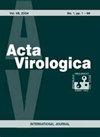新型La蛋白抑制剂nH115a:对乙型肝炎病毒感染的肝癌细胞中多种rna表达的影响及胚胎毒性分析
IF 0.8
4区 医学
Q4 VIROLOGY
引用次数: 0
摘要
La蛋白与RNA结合并保护乙肝病毒(HBV)的复制。我们最近开发了化合物nH115a,一种具有高稳定性和抗hbv活性的La蛋白抑制剂。然而,这种化合物抑制HBV感染的机制及其对胚胎的安全性仍不清楚。我们的目标是研究nH115a抑制HBV感染的分子机制,并表征其胚胎毒性。使用HepG2进行微阵列实验。2。利用15个细胞(通过将HBV质粒转染到HepG2肝癌细胞中建立)和生物信息学分析来测量nH115a对lncrna、mrna和circrna表达的影响。采用胚胎干细胞试验评价nH115a的胚胎毒性。nH115a显著改变2402个lncrna、338个mrna和559个circrna的表达。基因本体(GO)分析表明,差异表达的转录本在白细胞介素-2产生、I-SMAD结合、rna诱导沉默复合体(RISC)、NLRP3炎性复合体组装、核因子κ b (NF-κB)的细胞质隔离和死亡受体结合中起作用。京都基因和基因组百科全书(KEGG)分析显示,最富集的途径包括转化生长因子-β (TGF-β)信号通路、癌症通路、泛素介导的蛋白水解、p53信号通路、抗原加工和递呈、Fc γ r介导的吞噬和B细胞受体信号通路。胚胎干细胞试验结果表明,nH115a具有较弱的胚胎毒性。综上所述,免疫应答、TGF-β/SMAD信号和癌症相关途径可能在nh115a介导的HBV复制抑制中发挥作用。关键词:乙型肝炎病毒;La蛋白质;抑制剂;nH115a。本文章由计算机程序翻译,如有差异,请以英文原文为准。
nH115a, a novel inhibitor of the La protein: Effect on expression of multiple RNAs in hepatitis B virus-infected hepatoma cells and embryotoxicity profile.
The La protein binds to RNA and protects replication of the hepatitis B virus (HBV). We recently developed the compound nH115a, an inhibitor of the La protein that has high stability and anti-HBV activity. However, the mechanism, by which this compound inhibits HBV infection and its safety to embryos, remains unclear. Our goal was to examine the molecular mechanism, by which nH115a inhibits HBV infection, and to characterize its embryotoxicity. Microarray experiments using HepG2. 2. 15 cells (established by transfecting an HBV plasmid into HepG2 hepatoma cells) and bioinformatics analyses were used to measure the effect of nH115a on the expression of lncRNAs, mRNAs, and circRNAs. The embryonic stem cell test was used to assess the embryotoxicity of nH115a. nH115a significantly altered the expression of 2402 lncRNAs, 338 mRNAs, and 559 circRNAs. Gene Ontology (GO) analysis indicated the differentially expressed transcripts functioned in interleukin-2 production, I-SMAD binding, RNA-induced silencing complex (RISC), NLRP3 inflammasome complex assembly, cytoplasmic sequestering of nuclear factor kappa-B (NF-κB), and death receptor binding. Kyoto Encyclopedia of Genes and Genomes (KEGG) analysis indicated the most enriched pathways included transforming growth factor-β (TGF-β) signaling, pathways in cancer, ubiquitin mediated proteolysis, p53 signaling, antigen processing and presentation, Fc gamma R-mediated phagocytosis, and B cell receptor signaling. The results of the embryonic stem cell test indicated that nH115a exhibited weak embryotoxicity. In conclusion, immune responses, TGF-β/SMAD signaling, and cancer-related pathways may function in the nH115a-mediated inhibition of HBV replication. Keywords: hepatitis B virus; La protein; inhibitor; nH115a.
求助全文
通过发布文献求助,成功后即可免费获取论文全文。
去求助
来源期刊

Acta virologica
医学-病毒学
CiteScore
3.10
自引率
11.80%
发文量
43
审稿时长
>12 weeks
期刊介绍:
Acta virologica is an international journal of predominantly molecular and cellular virology. Acta virologica aims to publish papers reporting original results of fundamental and applied research mainly on human, animal and plant viruses at cellular and molecular level. As a matter of tradition, also rickettsiae are included. Areas of interest are virus structure and morphology, molecular biology of virus-cell interactions, molecular genetics of viruses, pathogenesis of viral diseases, viral immunology, vaccines, antiviral drugs and viral diagnostics.
 求助内容:
求助内容: 应助结果提醒方式:
应助结果提醒方式:


